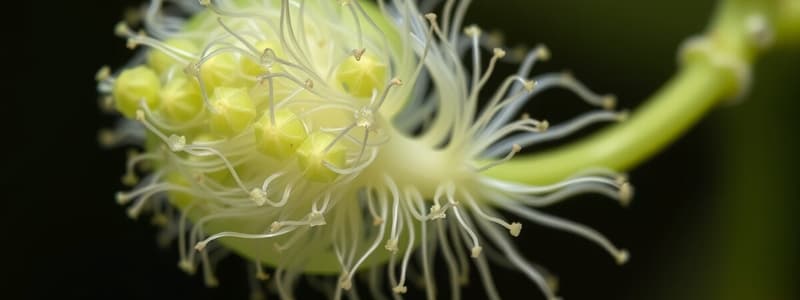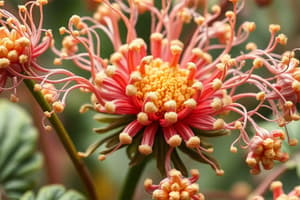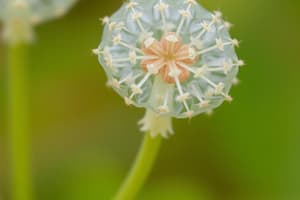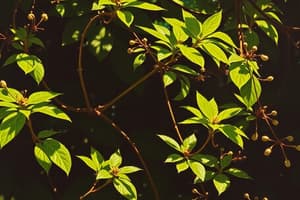Podcast
Questions and Answers
Which trait is not a shared characteristic between land plants and charophytes?
Which trait is not a shared characteristic between land plants and charophytes?
- Peroxisome enzymes
- Structure of flagellated sperm
- Chlorophyll b (correct)
- Rings of cellulose-synthesizing proteins
In the process of alternation of generations in plants, which phase is dominant in bryophytes?
In the process of alternation of generations in plants, which phase is dominant in bryophytes?
- Sporophyte
- Embryophyte
- Gametophyte (correct)
- Seedling
What is a distinct feature of seedless vascular plants compared to non-vascular plants?
What is a distinct feature of seedless vascular plants compared to non-vascular plants?
- Presence of vascular tissues (correct)
- Absence of true leaves
- Reproduction solely by spores
- Dependency on water for reproduction
Which statement correctly explains the difference between vascular and non-vascular plants?
Which statement correctly explains the difference between vascular and non-vascular plants?
Which of the following best describes the significance of the embryo's dependency on the parent plant?
Which of the following best describes the significance of the embryo's dependency on the parent plant?
Which of the following correctly identifies a derived trait of both bryophytes and seedless vascular plants?
Which of the following correctly identifies a derived trait of both bryophytes and seedless vascular plants?
What evolutionary trait do land plants have that distinguishes them from their aquatic ancestors?
What evolutionary trait do land plants have that distinguishes them from their aquatic ancestors?
Which phyla are primarily associated with non-vascular plants?
Which phyla are primarily associated with non-vascular plants?
Which structure is primarily responsible for the production of haploid spores in plants?
Which structure is primarily responsible for the production of haploid spores in plants?
What is the main ecological role of sporopollenin in spore walls?
What is the main ecological role of sporopollenin in spore walls?
Which of the following statements accurately describes bryophytes?
Which of the following statements accurately describes bryophytes?
Which of the following correctly distinguishes seedless vascular plants from nonvascular plants?
Which of the following correctly distinguishes seedless vascular plants from nonvascular plants?
Which group includes the 'naked seed' plants?
Which group includes the 'naked seed' plants?
What significance does the apical meristem hold in plants?
What significance does the apical meristem hold in plants?
Which of the following best describes the evolutionary timeline of land plants?
Which of the following best describes the evolutionary timeline of land plants?
What role do archegonia play in the reproductive cycle of plants?
What role do archegonia play in the reproductive cycle of plants?
What primary role do leaves play in vascular plants?
What primary role do leaves play in vascular plants?
Which statement accurately describes xylem in vascular plants?
Which statement accurately describes xylem in vascular plants?
Which term refers to the modified leaves that bear sporangia in seedless vascular plants?
Which term refers to the modified leaves that bear sporangia in seedless vascular plants?
In which of the following environments are gametophytes of seedless vascular plants typically found?
In which of the following environments are gametophytes of seedless vascular plants typically found?
How do roots benefit vascular plants in their growth?
How do roots benefit vascular plants in their growth?
What distinguishes megaphylls from microphylls?
What distinguishes megaphylls from microphylls?
Which of the following classifications includes plants that are not true mosses?
Which of the following classifications includes plants that are not true mosses?
What is a characteristic feature of sporophytes in seedless vascular plants compared to bryophytes?
What is a characteristic feature of sporophytes in seedless vascular plants compared to bryophytes?
What is the key function of sporopollenin in spore walls?
What is the key function of sporopollenin in spore walls?
Which of the following structures is primarily involved in the reproductive cycle of male plants?
Which of the following structures is primarily involved in the reproductive cycle of male plants?
Which statement best characterizes the relationship between bryophytes and vascular plants?
Which statement best characterizes the relationship between bryophytes and vascular plants?
How do seedless vascular plants reproduce compared to bryophytes?
How do seedless vascular plants reproduce compared to bryophytes?
What evidence suggests that plants have existed on land for at least 475 million years?
What evidence suggests that plants have existed on land for at least 475 million years?
Which of the following statements accurately describes the role of apical meristems in plants?
Which of the following statements accurately describes the role of apical meristems in plants?
What distinguishes vascular plants from nonvascular plants?
What distinguishes vascular plants from nonvascular plants?
Which evolutionary trait is a characteristic of gymnosperms among seed plants?
Which evolutionary trait is a characteristic of gymnosperms among seed plants?
What is the primary function of phloem in vascular plants?
What is the primary function of phloem in vascular plants?
Which statement best describes the sporophyte generation in seedless vascular plants?
Which statement best describes the sporophyte generation in seedless vascular plants?
What feature distinguishes microphylls from megaphylls?
What feature distinguishes microphylls from megaphylls?
Which of the following best explains the role of roots in vascular plants?
Which of the following best explains the role of roots in vascular plants?
What is a significant evolutionary development seen in seedless vascular plants?
What is a significant evolutionary development seen in seedless vascular plants?
How do sporophylls contribute to the reproductive process in seedless vascular plants?
How do sporophylls contribute to the reproductive process in seedless vascular plants?
Which phylum includes plants that have vascular tissues but are not classified as true mosses?
Which phylum includes plants that have vascular tissues but are not classified as true mosses?
What distinguishes homosporous plants from others in terms of spore production?
What distinguishes homosporous plants from others in terms of spore production?
What role do placental transfer cells play in the development of land plant embryos?
What role do placental transfer cells play in the development of land plant embryos?
Which phase dominates the life cycle of seedless vascular plants?
Which phase dominates the life cycle of seedless vascular plants?
How do non-vascular plants primarily differ from vascular plants in terms of nutrient transport?
How do non-vascular plants primarily differ from vascular plants in terms of nutrient transport?
Which derived trait is characteristic of all land plants, distinguishing them from their algal ancestors?
Which derived trait is characteristic of all land plants, distinguishing them from their algal ancestors?
What is the primary ecological role of vascular tissues in higher plants?
What is the primary ecological role of vascular tissues in higher plants?
Which statement accurately describes the life cycle of bryophytes?
Which statement accurately describes the life cycle of bryophytes?
What is a significant characteristic of seedless vascular plants that differentiates them from bryophytes?
What is a significant characteristic of seedless vascular plants that differentiates them from bryophytes?
What adaptation allows land plants to survive in terrestrial environments compared to their aquatic counterparts?
What adaptation allows land plants to survive in terrestrial environments compared to their aquatic counterparts?
Study Notes
Sporangia and Spores
- Sporangia are specialized organs in the sporophyte where spores are produced.
- Sporocytes, diploid cells, undergo meiosis to produce haploid spores.
- Spore walls contain sporopollenin, providing resistance to extreme conditions.
Multicellular Gametangia
- Gametes arise in structures called gametangia.
- Archegonia are female gametangia that produce eggs and facilitate fertilization.
- Antheridia are male gametangia responsible for producing and releasing sperm.
Apical Meristems
- Apical meristems enable continuous growth in plants.
- Cells from apical meristems differentiate into various tissue types.
Waxy Cuticle
- A waxy cuticle acts as a barrier to minimize water loss.
Origin of Plants
- Fossils suggest that terrestrial plants existed at least 475 million years ago.
- Fossilized spores and plant tissues have been discovered in 475-million-year-old rocks.
Vascular Tissues in Plants
- Plants can be categorized based on vascular tissue presence; vascular plants have these tissues, while nonvascular plants are known as bryophytes.
- Bryophytes do not form a monophyletic group, creating unresolved relationships among plant types.
- Seedless vascular plants include:
- Lycophytes (club mosses and relatives)
- Monilophytes (ferns and relatives)
- Seedless vascular plants are paraphyletic and represent a similar biological organization level.
Seeds and Clade Formation
- Seeds consist of an embryo, nutrient supply, and a protective coat.
- Seed plants are classified as a clade that further divides into:
- Gymnosperms ("naked seed" plants like conifers)
- Angiosperms (flowering plants)
Adaptations of Plants to Land
- Land plants share traits only with charophytes, such as rings of cellulose-synthesizing proteins and specific enzyme structures in peroxisomes.
- Ongoing debates exist on potentially expanding the plant kingdom to include certain green algae.
- "Embryophytes" defines land plants based on their embryo development.
Derived Traits of Plants
- Plants exhibit alternation of generations, alternating between multicellular haploid (gametophyte) and diploid (sporophyte) stages.
- The gametophyte produces gametes via mitosis; gamete fusion creates a diploid sporophyte producing haploid spores through meiosis.
- The embryo remains dependent on the female gametophyte for nutrition.
Life Cycles and Dominant Generations
- In seedless vascular plants, the sporophyte dominates, contrasting with the bryophytes where gametophytes are dominant.
- Sporophytes in seedless vascular plants are typically larger than gametophytes.
Vascular Tissue Functionality
- Vascular plants possess xylem and phloem:
- Xylem: Carries water and minerals with dead, lignin-structured cells.
- Phloem: Transports sugars and organic nutrients using living cells.
Roots and Leaves
- Roots anchor vascular plants and facilitate water and nutrient uptake; likely evolved from subterranean stems.
- Leaves serve to expand plant surface area for enhanced solar energy capture, crucial for photosynthesis.
- Leaf types:
- Microphylls: single vein structure
- Megaphylls: intricate branched vascular setup
Sporophylls
- Sporophylls are modified leaves bearing sporangia, essential for reproduction.
- Sori are clusters of sporangia found on sporophyll undersides.
- Strobili are cone-like structures formed from aggregated sporophylls.
- Most seedless vascular plants tend to be homosporous, generating a single spore type that develops into a bisexual gametophyte.
Classification of Seedless Vascular Plants
- Phylum Lycophyta includes club mosses, spike mosses, and quillworts; these possess vascular tissues but are distinct from true mosses.
Sporangia and Spores
- Sporangia are specialized organs in the sporophyte where spores are produced.
- Sporocytes, diploid cells, undergo meiosis to produce haploid spores.
- Spore walls contain sporopollenin, providing resistance to extreme conditions.
Multicellular Gametangia
- Gametes arise in structures called gametangia.
- Archegonia are female gametangia that produce eggs and facilitate fertilization.
- Antheridia are male gametangia responsible for producing and releasing sperm.
Apical Meristems
- Apical meristems enable continuous growth in plants.
- Cells from apical meristems differentiate into various tissue types.
Waxy Cuticle
- A waxy cuticle acts as a barrier to minimize water loss.
Origin of Plants
- Fossils suggest that terrestrial plants existed at least 475 million years ago.
- Fossilized spores and plant tissues have been discovered in 475-million-year-old rocks.
Vascular Tissues in Plants
- Plants can be categorized based on vascular tissue presence; vascular plants have these tissues, while nonvascular plants are known as bryophytes.
- Bryophytes do not form a monophyletic group, creating unresolved relationships among plant types.
- Seedless vascular plants include:
- Lycophytes (club mosses and relatives)
- Monilophytes (ferns and relatives)
- Seedless vascular plants are paraphyletic and represent a similar biological organization level.
Seeds and Clade Formation
- Seeds consist of an embryo, nutrient supply, and a protective coat.
- Seed plants are classified as a clade that further divides into:
- Gymnosperms ("naked seed" plants like conifers)
- Angiosperms (flowering plants)
Adaptations of Plants to Land
- Land plants share traits only with charophytes, such as rings of cellulose-synthesizing proteins and specific enzyme structures in peroxisomes.
- Ongoing debates exist on potentially expanding the plant kingdom to include certain green algae.
- "Embryophytes" defines land plants based on their embryo development.
Derived Traits of Plants
- Plants exhibit alternation of generations, alternating between multicellular haploid (gametophyte) and diploid (sporophyte) stages.
- The gametophyte produces gametes via mitosis; gamete fusion creates a diploid sporophyte producing haploid spores through meiosis.
- The embryo remains dependent on the female gametophyte for nutrition.
Life Cycles and Dominant Generations
- In seedless vascular plants, the sporophyte dominates, contrasting with the bryophytes where gametophytes are dominant.
- Sporophytes in seedless vascular plants are typically larger than gametophytes.
Vascular Tissue Functionality
- Vascular plants possess xylem and phloem:
- Xylem: Carries water and minerals with dead, lignin-structured cells.
- Phloem: Transports sugars and organic nutrients using living cells.
Roots and Leaves
- Roots anchor vascular plants and facilitate water and nutrient uptake; likely evolved from subterranean stems.
- Leaves serve to expand plant surface area for enhanced solar energy capture, crucial for photosynthesis.
- Leaf types:
- Microphylls: single vein structure
- Megaphylls: intricate branched vascular setup
Sporophylls
- Sporophylls are modified leaves bearing sporangia, essential for reproduction.
- Sori are clusters of sporangia found on sporophyll undersides.
- Strobili are cone-like structures formed from aggregated sporophylls.
- Most seedless vascular plants tend to be homosporous, generating a single spore type that develops into a bisexual gametophyte.
Classification of Seedless Vascular Plants
- Phylum Lycophyta includes club mosses, spike mosses, and quillworts; these possess vascular tissues but are distinct from true mosses.
Studying That Suits You
Use AI to generate personalized quizzes and flashcards to suit your learning preferences.
Description
This quiz covers essential concepts of plant biology, focusing on sporangia, gametangia, and the structures involved in plant reproduction and growth. Explore the role of apical meristems, vascular tissues, and plant origins through a series of engaging questions.



